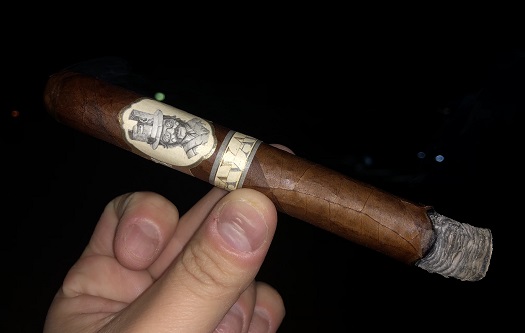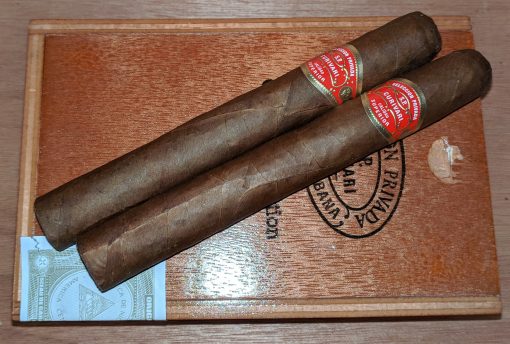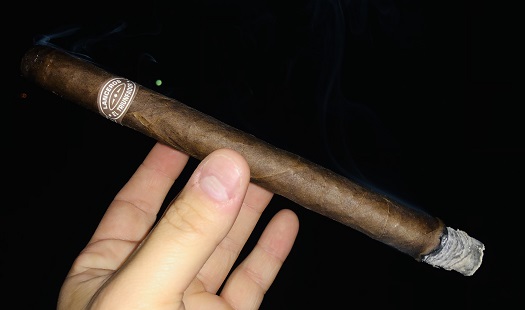Cigar Review: La Palina El Año 1896 Oscuro Robusto
19 Nov 2018

Before we get to smoking this cigar, let’s clear up some confusion about what it is. And what it isn’t.
The blend and the production location are no longer what they were. The new version of La Palina El Año 1896 Oscuro uses a Costa Rican oscuro wrapper, a Dominican binder, and Dominican and Nicaraguan filler. It’s rolled at the Plascencia factory in Honduras.
This information comes directly from La Palina. The confusion arises because the cigar was redone, and a number of online sites haven’t updated their particulars.
As for the Robusto, it is a 5-inch, 52-ring gauge, box-pressed stick with a price tag of $9.50. A sheath that features both the cigar name and the now-familiar image of brand owner Bill Paley’s paternal grandmother, Goldie, covers more than half the cigar. When all is peeled away, it reveals a dark wrapper with little pre-light aroma.
El Año 1896’s name pays tribute to the year La Palina cigars made their first appearance in the market. La Palina’s new incarnation debut came in 2010.
The smoking experience of El Año 1896 is as smooth as the nearly vein-free wrapper. Strength is in the medium range with modest pepper and spice.
One of the more pleasing, and somewhat surprising, flavors I encountered was a piquant citrus at about the halfway point. The zesty sensation remained and contrasted nicely with the occasional tobacco sweetness. Also appearing in the second half was an intermittent earthy mushroom note.
The burn was slow. Smoke production was high and the ash held tightly. I had to make a couple minor burn corrections on two of the three I smoked, but nothing to significantly mar the experience.
Overall, I’d say La Palina has another winner on its hands. El Año 1896 is a tasty cigar that should appeal across the board. I rate it four stogies out of five.

[To read more StogieGuys.com cigar reviews, please click here.]
–George E
photo credit: Stogie Guys


 Yamasá highlights a tobacco that celebrates what Davidoff calls “Master Blender Henke Kelner’s impossible dream to turn the unforgiving swampland of the Yamasá region into a successful tobacco-growing field.†It makes for a smooth wrapper and is also used for the binder. The filler is a combination of Nicaraguan and Dominican leaves.
Yamasá highlights a tobacco that celebrates what Davidoff calls “Master Blender Henke Kelner’s impossible dream to turn the unforgiving swampland of the Yamasá region into a successful tobacco-growing field.†It makes for a smooth wrapper and is also used for the binder. The filler is a combination of Nicaraguan and Dominican leaves.


 Quai d’Orsay was created to appeal to French tastes, which was believed to favor milder cigars. The line was reportedly created by Cubatabaco in 1973 at the request of SEITA. SEITA managed the brand outside of the purview of Cuban cigar distribution company Habanos S.A., until SEITA merged with Spanish tobacco company Altadis, which later purchased a 50% stake in Habanos.
Quai d’Orsay was created to appeal to French tastes, which was believed to favor milder cigars. The line was reportedly created by Cubatabaco in 1973 at the request of SEITA. SEITA managed the brand outside of the purview of Cuban cigar distribution company Habanos S.A., until SEITA merged with Spanish tobacco company Altadis, which later purchased a 50% stake in Habanos.

 Long Live the King was one of Caldwell’s original lines. It sports a Dominican Corojo wrapper and binder, along with filler tobaccos from Nicaragua (Habana Ligero) and Peru (Pelo de Oro). It is marketed as a full-bodied, small-batch cigar made from grade-A tobaccos.
Long Live the King was one of Caldwell’s original lines. It sports a Dominican Corojo wrapper and binder, along with filler tobaccos from Nicaragua (Habana Ligero) and Peru (Pelo de Oro). It is marketed as a full-bodied, small-batch cigar made from grade-A tobaccos.
 I’ve long appreciated Curivari’s offerings for the value they provide and, frankly, I expected that in our hundreds of reviews we would have visited the Curivari line more than just twice. But apparently we haven’t. So today we look at another Curivari blend: the Curivari Seleccion Privada Coronation.
I’ve long appreciated Curivari’s offerings for the value they provide and, frankly, I expected that in our hundreds of reviews we would have visited the Curivari line more than just twice. But apparently we haven’t. So today we look at another Curivari blend: the Curivari Seleccion Privada Coronation.
 Back when the line, which is Spanish for “triumphant,†was introduced in 2008, El Triunfador only came in one size: a
Back when the line, which is Spanish for “triumphant,†was introduced in 2008, El Triunfador only came in one size: a  Patrick Ashby
Co-Founder & Editor in Chief
Patrick Ashby
Co-Founder & Editor in Chief Patrick Semmens
Co-Founder & Publisher
Patrick Semmens
Co-Founder & Publisher George Edmonson
Tampa Bureau Chief
George Edmonson
Tampa Bureau Chief